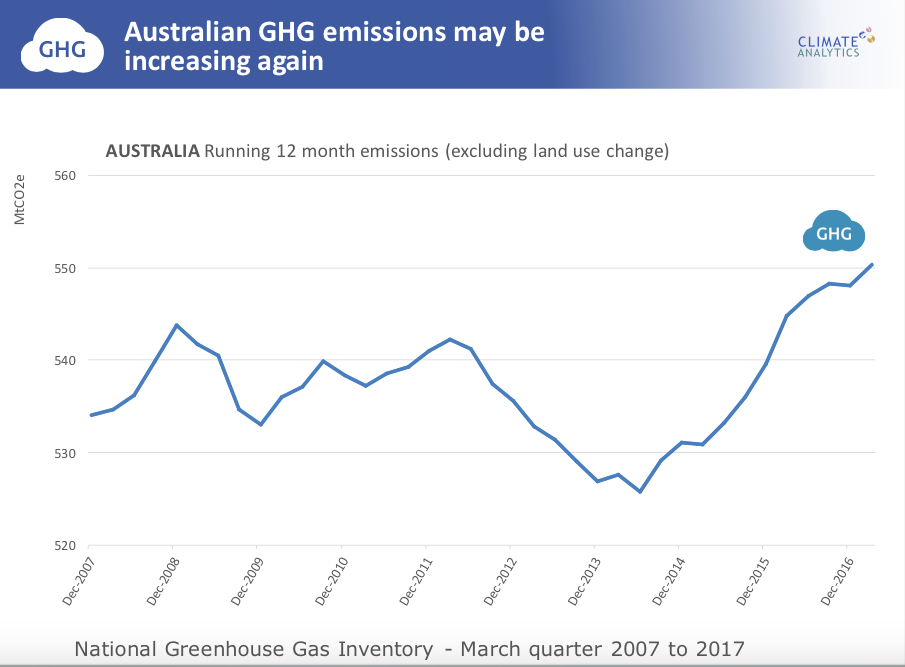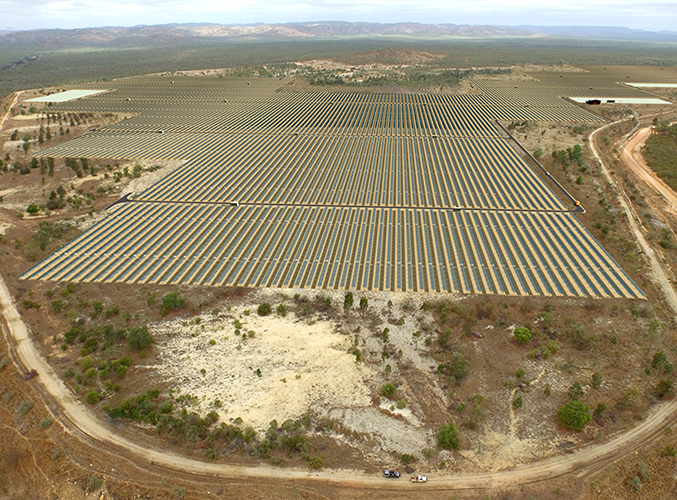Bill Hare, a Perth-based climate scientist and director of research group Climate Analytics, says there is renewed pressure for the world to act to cap average global warming at 1.5°C given the increasing evidence of extreme weather events, heat-waves, coral bleaching and other impacts.
Despite the Paris agreement to keep average global warming “well below” 2°C, and possibly to 1.5°C, the world is heading towards a minimum rise of 2.8°C, and the carbon “budget” to meet more ambitious targets is rapidly depleting.
Australia is also increasing its emissions, with the electricity sector recently reversing course after the scrapping of the carbon price.
One way to address this was to develop a strategy to move towards a 100% renewable energy system by the 2030s, and a long term plan to reach net zero greenhouse gas emissions in the 2040s. Australia, Hare says, is well placed to lead the world, because of its excellent natural resources.
It could use surplus renewable energy for generating energy carriers and duplicate the LNG industry – but with clean fuels – and the mining and metals industry would benefit from meeting growing demand for high tech metals in a 1.5°C world.
“There is no fundamental technological limit to renewable energy integration to existing energy system,” says Hare, who delivered a major lecture, The Keith Roby Memorial Lecture at Murdoch University, in Perth this week.
His comments come on the same day as a 27-strong team from Stanford University, led by Mark Jacobsen, released an updated plan on how 139 countries, including Australia, could reach 100% renewables based around wind, solar, storage and hydro.
The group has developed roadmaps, including for Australia, on how to reach an average 80% renewable energy by 2030 and 100 per cent by 2050.
It includes details of how much land and how many rooftops these power sources would require; and how the proposals for each country would reduce energy demand and cost when compared to a business-as-usual scenario.
If the 100% renewable energy targets seem outlandish, and the work of ideological researchers at NGOs and universities, as the detractors have wasted no time in claiming, they should be put into some context.

Four of the world’s biggest companies – Apple, Amazon, Google and Facebook, have vowed to source all their electricity needs from renewable energy within a few years, and they have also been joined by the likes of IKEA and brewing giant In-Bev, the owner of Foster’s.
Other Australian major energy users, like Sun Metals, Telstra, the Whyalla steel plant, Nectar Farms, and numerous smaller businesses are also investing heavily in wind and solar and storage, some up to the level of 100%.
The Australian network operator Transgrid says 100 per cent renewable energy is both feasible and affordable, and the network lobby, Energy Networks Australia, put together a detailed path with the CSIRO on how to decarbonise the Australian grid in the 2040s.
And, Hare notes, ANU’s Andrew Blakers has suggested that doubling the current combined PV and wind installation rate to around 6GW per year would enable the country to reach 100 per cent renewable electricity in about 2033.
Popular content
This contrasts with the federal government’s position that even 50 per cent renewable energy by 2030 is “reckless’, and the strong push-back from the coal lobby and conservative commentators that the 42 per cent renewable energy level by 2030 contemplated by the Finkel Review would also be a disaster.
Hare’s argument is that the pace of change is accelerating on two fronts – on the climate and environmental impacts of global warming, already been felt in barrier reefs and extreme and changing weather events; and from the falling cost of clean technologies.
He agrees with the likes of Professor Ross Garnaut and UNSW solar pioneer Martin Green that Australia can greatly benefit from positioning itself as a source of cheap, clean energy.
“We can still be the lucky country,” Hare says of the transition. “Australia has massive renewable energy resources – more so than most.
“Australia also has many of the high tech metals the world will need; we have first rate science and technology
development; we have excellent engineering and latent manufacturing capacity; we have a highly skilled and productive work force; and we have excellent logistics.”
Hare says that what Australia does need is a new “future oriented” international strategy on climate change that advances global action to meet the 1.5°C limit, whilst taking sustainable advantage of its renewable energy and natural resources.
“Growth of coal and natural gas demand in our region is a threat to us, not an opportunity,” Hare says. “Pivoting to a strategy of developing an export market for renewable energy carriers and low carbon, hi-techminerals would turn this into a major economic opportunity.”
Hare notes that Australia’s emissions are headed in the wrong direction, and the current Federal Government focus on coal and gas risks missing the big “turn” that other countries are now making.
Hare says it is clear that new build renewables are cheaper than fossil fuels, and that there are increasing number of options to balance the grid- including battery storage, pumped hydro, solar thermal, and renewable-based hydrogen, which present massive export opportunities.
Indeed, ARENA has commissioned a study into Australia’s options for “dispatchable generation” and will deliver its report early in the New Year, while AEMO is also expected to shortly release its assessment of “base-load” power needs after being asked to do so by the federal government.
Hare cites the cost of solar PV, wind, battery storage and other technologies are falling fast, the carbon technologies offer new economic opportunities, but the federal government has instead chosen to focus on coal and gas assets that risk becoming stranded investments.
Article reproduced with permission from RenewEconomy.
This content is protected by copyright and may not be reused. If you want to cooperate with us and would like to reuse some of our content, please contact: editors@pv-magazine.com.


“The world is heading towards a minimum rise of 2.8°C, and the carbon “budget” to meet more ambitious targets is rapidly depleting.”
The second of these propositions is undoubtedly true. The former is typically based on taking the Paris NDCs literally. This is unwise. The USA may fall short of its commitments, but coal has recently been declining faster than in the CPP scenario, so it’s unlikely the USA will fall significantly short even under a Trump do-nothing policy. On the other hand, China and India will beat their (very soft ) NDC goals by large margins. China’s coal burn fell several years running, and the current uptick is likely to be short-lived: it seems to be provincial Party cadres ensuring good GDP numbers in advance of the Party congress. Indian coal plans have recently been scaled back sharply, and there is a freeze on starts for new coal plants. I would like to see an analysis of BAU trends that is based on current data, and expect it would come out quite a bit closer to a 2 degree outturn. The real problem is that 2 degrees is still unsafe.